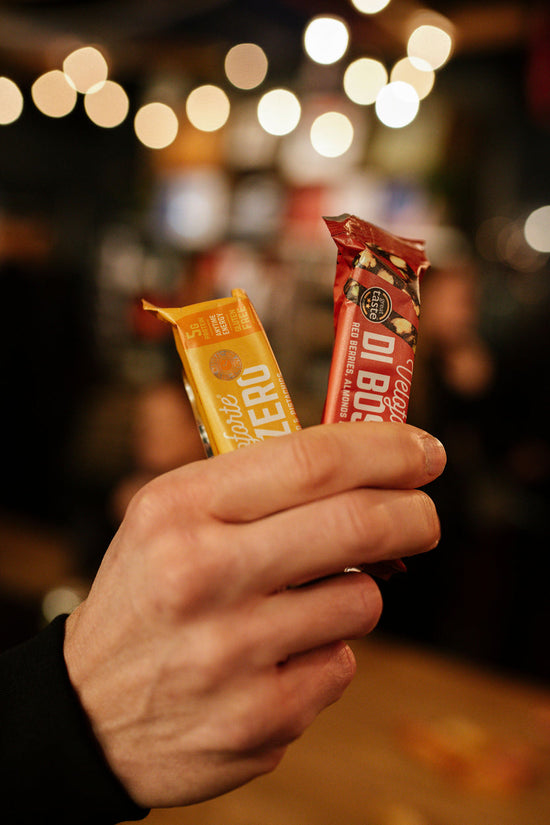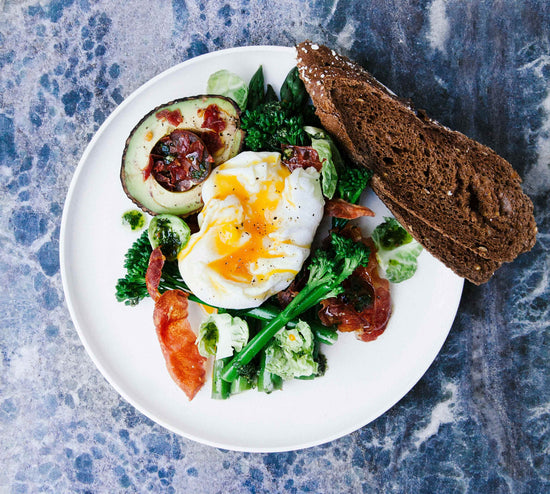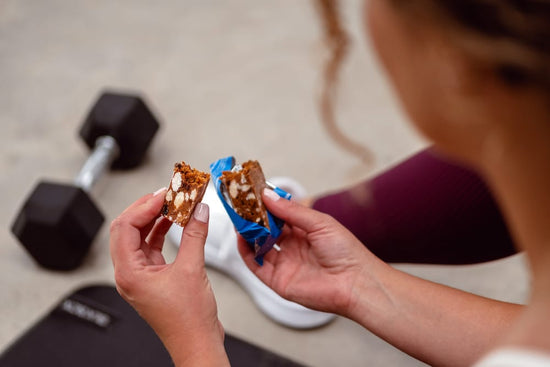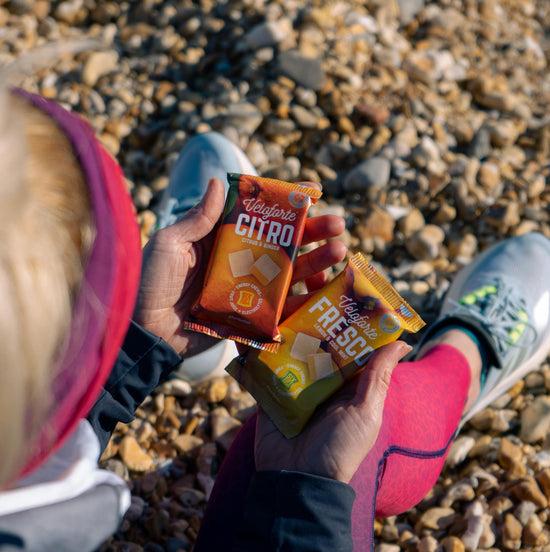Energy bars are a compact, portable source of carbohydrate energy, which can be eaten before, during and after exercise. Some are made from natural ingredients, and others rely on synthetic sugars and additives. There’s a big variety in styles, textures, flavours and also in nutritional value.
In this article we’ll break down what makes an energy bar, how Veloforte bars differ from other types of bar, and what you should be looking for in a good energy bar.
What makes it an energy bar?
An energy bar in its most basic form is a way of delivering energy, in the form of carbohydrates, to the body, usually to fuel exercise or activity.
Those carbohydrates can come from natural sources like fruits, honey, plant syrups and grains, or from processed starches and manufactured sugars.
Energy bars can come in a variety of different flavours and textures but are generally designed to be portable, easy to transport when exercising and easy to eat on the go.
Often an energy bar will contain additional elements like caffeine, electrolytes or protein.
There are lots of different types of bars on the market — check out our guide to choosing the best energy bars.
What do energy bars do?
Your body stores carbohydrate energy as glycogen within your muscles which depletes during exercise. When you eat an energy bar the carbohydrates, including sugars, in that bar top up your body’s fuel and give your body an energy boost to keep you going stronger for longer.
What are energy bars good for?
If you’re leading an active lifestyle and eating well, a healthy energy bar is a great addition, providing a much needed energy boost.
Athletes will often take on an energy bar before a workout, to give them enough carbohydrate energy to keep pushing.
Some energy bars can also make for a healthy snack. Those like Veloforte contain real foods like nuts and fruit that provide vital fibre which helps your body digest the carbohydrates more slowly, as well as healthy vitamins and minerals.
Be aware that even a totally natural energy bar like ours still has a reasonably high amount of natural fruit sugars. They make a good snack to restore burnt calories or as part of a healthy, active lifestyle — but if you’re eating badly or not being active, then they won’t magically make you healthy.
How is an energy bar different from other bars?
Protein bars
As the name suggests, protein bars are designed to efficiently deliver protein to your body, which can be digested and used to help build and repair muscles. They are generally used after exercise.
Some protein bars pride themselves on having very low sugar and carbohydrate content. This means that they’re generally not a good choice for an energy boost while exercising (though taking on protein during exercise becomes more important the longer your workout — think ultramarathons and long days on the bike).
Others, like our Mocha and Forza bars, combine natural protein with carbohydrates for a dual approach to recovery & long day fuelling.
The protein in protein bars can come from a number of sources, the most popular being whey (from milk), soy, pea, brown rice, and sometimes nuts or egg whites. Look for complete protein sources for optimal recovery.
Granola bars and cereal bars
Cereal bars are usually marketed towards children. They tend to be high in added sugars, and not much else.
Granola bars are often very similar in nutritional value to kids’ cereal bars, but these have been very successfully marketed towards adults, often as an alternative to breakfast.
Both could be a useful source of carbs for strenuous exercise. Just be aware that they tend to be lacking in other nutrients.
Veloforte Oat Snack Bars are a great source of fibre, omega 3 heart healthy fats and slow release energy. Naturally delicious, with no added sugar and at 136 calories per bar, they are a smarter snack choice for all the family.
Weight loss bars
Some bars on the market claim to help with weight loss. They are usually low in calories and low in nutrients too. Be aware that any product which promises weight loss as this generally relies on a host of artificial chemicals, usually with a lack of evidence to support their claims.
Keto bars
‘Keto’ diets have become increasingly popular in recent years. The theory goes that you can train your body to efficiently use fat, rather than carbohydrates, as its main fuel source. Therefore, Keto bars tend to be high in fats and proteins, with little to no carbohydrates. The good news is that they’re often made of natural ingredients. The less good news is that, for the majority of people, they won’t provide the energy you need to keep going.
The jury’s out on the effectiveness of a keto diet on endurance exercise performance and long term healthiness of Keto diets.
What to look for in an energy bar
It’s important to consider that our energy needs are all different. Perhaps you need a quick burst of energy for a HIIT session, or several hundred grams of carbs for a 100k run. The first thing to look for is how many grams of carbs an energy bar will give you.
Next, look at the type of carbs. Are they from synthetic sugars? Natural sources? Better yet, a combination of different natural carbs and sugars?
Whatever you need your energy bar for, we’d always recommend taking a good look at the ingredients. Are you seeing real foods like fruit, nuts and grains — or a long list of unrecognisable chemicals? What is the bar like in terms of vitamins and nutrients? (Or is it the equivalent of eating a handful of sugar?)
Thankfully, Veloforte’s energy bars are packed full of natural dual-source carbohydrates to keep your energy sustained, heart healthy fats & plant based proteins that also cater to those on vegan and gluten free diets.
Why Veloforte?
By harnessing nature’s finest ingredients, we craft real food that really works by delighting your senses and enhancing your daily physical performance, productivity & wellness, naturally.
No compromises, digestive issues, fake flavours, sickly gloop or ingredients you can't spell (or digest). Instead, beautifully balanced natural ingredients, incredible flavours and enjoy total confidence in your foundational health, well-being and performance.
For athletes and adventurers everywhere, our range is fit for purpose and fit for body... created to help you #fuelbetter.










